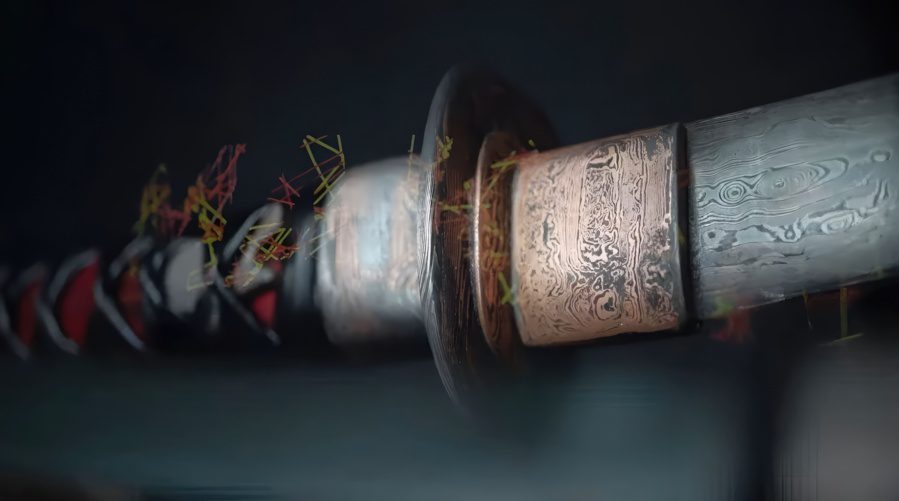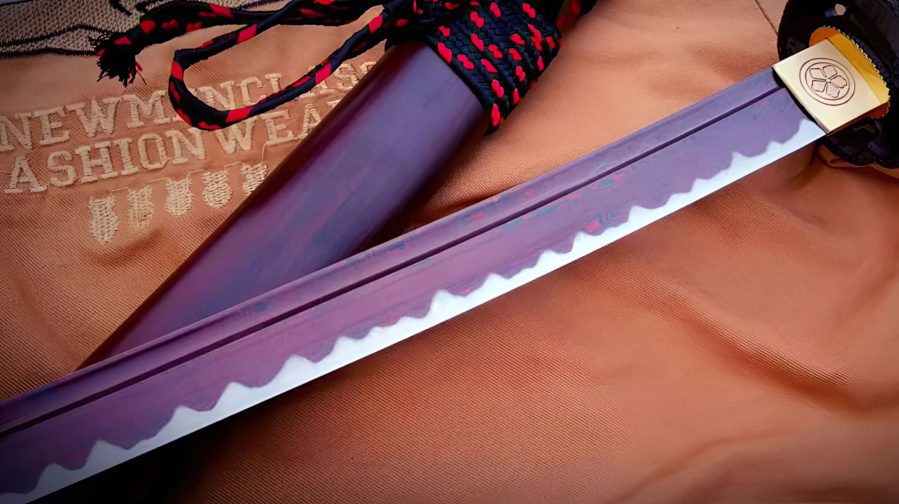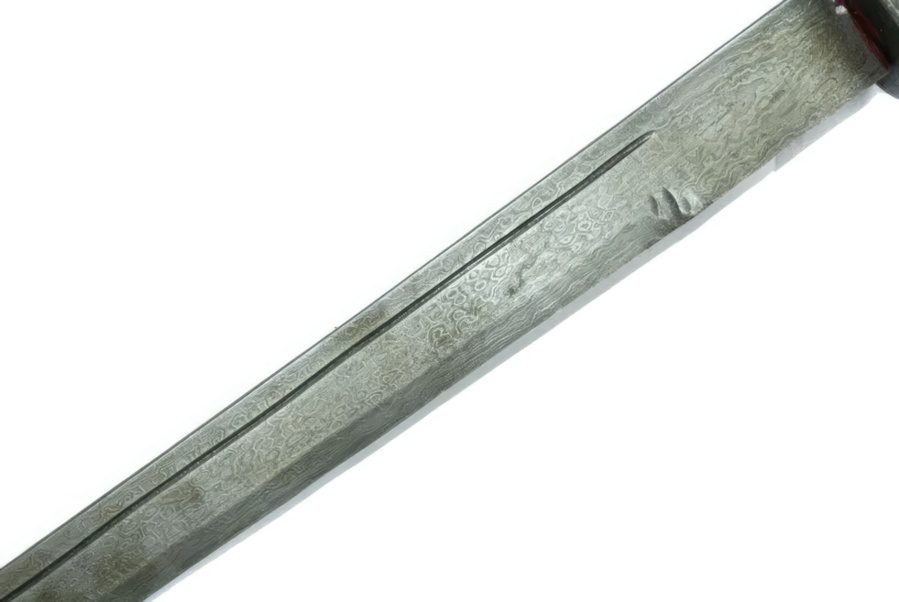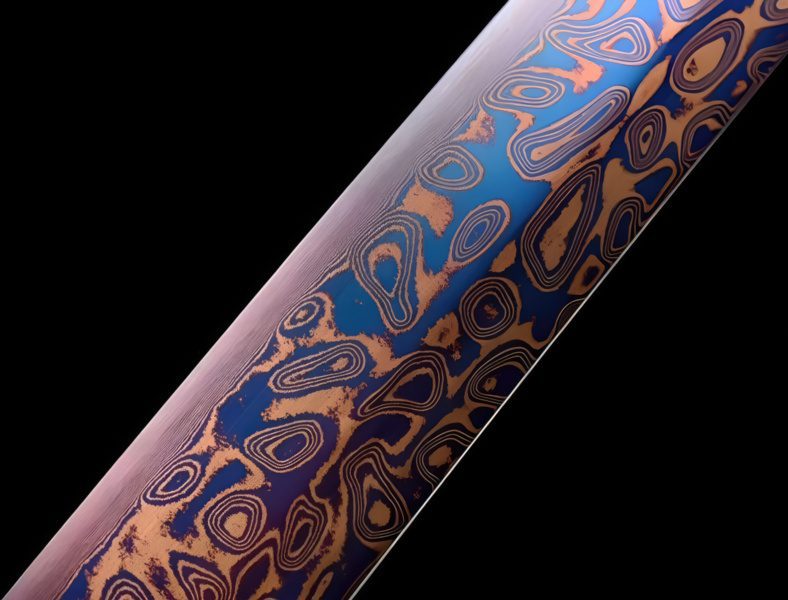How Much is a Damascus Katana?

What’s in this article?
Damascus katana swords are some of the most expensive on the sword market today. Their higher price tags are often the result of the advanced craftsmanship required to create their beautiful water-like blade patterns. While aesthetic quality is often key with Damascus katanas, there are also affordable Damascus blade options worth considering.
In this article, we will detail how much a Damascus katana costs. We will first clarify what “Damascus” means while discussing the uniqueness of its quality and a bit about its history. Afterward, we will explore the different price factors that make up a Damascus steel katana sword and what you should consider when looking for one.
What is a Damascus Katana?

Damascus katana refers to a Japanese katana sword made with Damascus steel. Many people particularly celebrated and favored this steel due to its distinctive blade patterns, achieved by modern forge welding or historic iron and steel manipulation during solidification. These unique patterns enrich the blade’s visuals with water-wavy-like shapes, drops and ripples, and light and dark lines.
The term “Damascus” originates from the ancient type of steel widely produced during the 9th century in Damascus, today the capital of Syria. The city was a trading hub that produced high-quality patterned blades likely borrowed from wootz steel created in India and Sri Lanka.
While historically, Japan imported and adopted many of the steel-producing techniques from other cultures; there are almost no instances of wootz or Damascus steel properties on their blades. The Japanese blade grain pattern, called jigane and jihada, comes from folding the blade in its creation. Although not rooted in historical authenticity, Damascus katanas are highly sought after primarily for their captivating aesthetics.
Damascus Katana Price Factors

Damascus katana swords can be made in different styles and with different methods, making their prices range from $80 to over $5000. The ancient method of Damascus crafting has widely been lost, with the exception of very few artisans worldwide.
Today, manufacturers can use different methods to closely mimic the visual patterns of the Damascus blade as much as possible.
Here are the most important factors that determine the price of a Damascus katana sword.
- Craftsmanship – whether a Damascus katana has been individually hand-forged, machine-forged and follows different methods such as wire brushing, forge-welding, folding, or acid etching
- Material – the use of high or low-quality steel will give the blade different attributes, such as better corrosion resistance or stronger cutting power
- Aesthetics – the more vibrant colors, shapes, and blade patterns closely resembling the original Damascus design. Incorporating modern and custom welded steel patterns or real Damascus wootz patterns will require more work and effort, increasing the price of the katana
- Engravings & Fittings – the number of engravings on the Damascus steel blade as well as the use of Damascus steel on the koshirae fittings such as the tsuba handguard
When considering how much to pay for a Damascus katana, evaluating these factors behind it is recommended. Many Damascus katanas with inferior quality imitate the style of a katana made from authentic Damascus and are strictly made to be enticing to the eye. There are also Damascus katanas that can be functional, while the majority are made to be display pieces.
Types of Damascus Katanas
Almost all Damascus katana swords have the Damascus style pattern. These patterns can be achieved in several methods, and while looking equally beautiful, some are real, while others just mimic the authentic Damascus blade shape. The sword’s function will also place the Damascus katana in a different price category.
Real Damascus Katana

- $1200 or more
The art of making a real Damascus steel sword is limited to 200 artisans worldwide. Therefore, making an authentic Damascus, known as wootz or crucible, katana is still possible, but only by custom ordering from these individual experienced blacksmiths. The real Damascus katana doesn’t have to be created by Japanese swordsmiths to be authentic or folded to get its distinctive and unique blade patterns.
These are made during the ingot’s or steel’s solidification and are manipulated while drawing it out into a longer blade shape. This process takes considerable time and precise attention to detail, raising its price tag more significantly than other modern types of Damascus katanas.
Modern Damascus Katana (Forge Welded)

- $300 – $1200
The modern and popular Damascus katana steel type seen in various sword markets is made by forge-welding different types of iron and steel on top of each other, creating a billet of steel that can be folded many times, which will, in turn, create visual-like Damascus blade patterns. While doing so, however, air gaps are induced into the blade, compromising its integral structure.
This Damascus steel craft was discovered in modern times. While bringing the look of an authentic and true Damascus blade pattern, it isn’t the true and authentic method, as it has been fully documented and widely researched today, reflecting their lower price tags.
Despite that, the modern Damascus katana patterns are close to the original and made to be subtle to the eye. A good way to determine if a sword was truly welded and has the Damascus water-like shapes is to closely shine a flashlight on the blade.
The modern Damascus swords have impurities but can be functional if they’re welded with steels such as 1060 carbon, 5160 spring, or t10 tool steel and used on light-cutting targets.
Decorative Damascus Katana

- $80 – $300
Some Damascus katana swords can be purely decorative. They can be produced from iron and steel as the previously mentioned types, but they might be falsely etched or folded excessively. Doing so will give them more beautiful layers but also more air gaps, making them less functional.
Some decorative Damascus katanas can have unnatural Damascus designs, which can be achieved in several ways, such as wire brushing or acid or laser etching. Damascus katanas can also be made from stainless steel, which is more rust-resistant, making it a great sword display piece.
These Damascus katanas may have a Damascus-like blade pattern but will lack the Damascus steel inherent characteristics. When the blades of these Damascus katanas are hard-polished, their patterns disappear because they can only be decorated on the blade’s surface. That is why consulting a guide to determine a real Damascus sword from a forged one is advisable.




